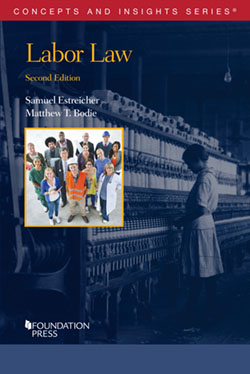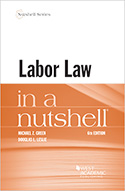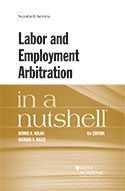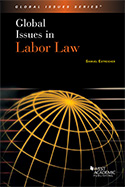
Labor Law
Authors:
Estreicher, Samuel / Bodie, Matthew T.
Edition:
2nd
Copyright Date:
2020
21 chapters
have results for Labor Law
Chapter 1. Introduction to U.S. Labor Law 61 results (showing 5 best matches)
- The principal U.S. labor law is the National Labor Relations Act of 1935 (NLRA or Wagner Act). The NLRA applies to all employers in private industries “affecting commerce,” with the exception of the railroad and airlines industries. Labor relations in the latter industries are regulated by the Railway Labor Act of 1926 (RLA). Both the NLRA and RLA broadly preempt all state regulation of labor relations in the industries they cover. The states have enacted “mini Wagner Acts” for private industries not regulated by federal law and public sector labor relations laws for the employees of state and local governments. The federal government has a separate labor relations statute for its employees.
- Labor law regulates collective action by workers concerning wages, hours, and working conditions and employer countermeasures in such disputes. It is a legal regime that deals with the economic and legal relationships between sellers of labor, acting as a collectivity, and actual or prospective purchasers of labor. Many times, employees will have chosen a labor organization—a union—to represent them collectively. But all employees have rights under labor law to engage in collective action for mutual gain, whether or not they are represented by—or even have any interest in joining—a union.
- The principal focus of this book is on the federal labor laws governing private employees. The labor relations of federal, state, and local government employees are subject to the government-sector labor laws of those jurisdictions. One principal exception on the federal level is the Postal Reorganization Act, , which established the U.S. Postal Service and provided for partial application of the provisions of the National Labor Relations Act, which is the basic labor law for the private sector.
- Labor law is one of three primary areas of workplace law, the others being employment discrimination law and employment law. Employment discrimination law concerns the legal prohibition of employment decisions based on an individual’s race, sex, age, religion, national origin, disability and other status characteristics usually bearing no relationship to legitimate employer considerations. Employment law covers the rights and obligations of individual employees as to minimum wage, overtime, health and safety, and a myriad other specific mandates, without regard to whether or not they are represented by labor unions. Labor law, by contrast, is about collective action.
- The economics of labor markets and the effects of unions and collective bargaining on these markets remain the subject of vigorous public policy debate. Labor law enhances the bargaining power of workers by providing a legally protected means to organize and bargain collectively. Whether this power is beneficial, either to individual employees or society as a whole, remains contested terrain. Our labor laws are premised on the notion that the welfare of the United States is best served by facilitating collective bargaining and recognizing the rights of workers to engage in collective activity for their mutual gain or protection. We now turn to the basic structure of U.S. labor law.
- Open Chapter
Chapter 2. Historical Evolution of U.S. Labor Relations System 89 results (showing 5 best matches)
- The British have substantially altered their labor relations law in the direction of the U.S. model with the provision of representation elections, a legal duty to bargain with elected majority representative, and strike-ballot rights for union-represented employees. See Samuel Estreicher, Global Issues in Labor Law 205–08 (2007).
- In 1914, President Woodrow Wilson issued a call for changes in the antitrust laws and for creation of a federal trade commission. Labor saw this as an opportunity to revive its campaign for a labor exemption from the antitrust laws. Wilson rejected the demand for a wholesale exclusion from antitrust scrutiny, and the Clayton bill that passed the House and became the Clayton Act did not incorporate the AFL’s broad exclusionary language. Nevertheless, labor’s supporters noted that the Act recognized that the labor of a human being was not an article of commerce and restricted labor injunctions, insisting that the measure in effect legalized the secondary boycott. In AFL president Samuel Gompers’s terms, the Clayton Act was “Labor’s Magna Carta.”
- The Labor Injunction
- Section 6 states that “[t]he labor of a human being is not a commodity or article of commerce” and that nothing in the antitrust laws would forbid or restrain labor organizations from “the[ir] legitimate objects.” The
- The Norris-LaGuardia Act can be characterized as an attempt to perfect the common-law model for regulating labor disputes rather than as an effort to promote labor organization directly. It was designed to afford unions an opportunity to organize free of the improper restraints of government.
- Open Chapter
Chapter 11. Labor and the Antitrust Laws 12 results (showing 5 best matches)
- The statutory exemption extends to certain combinations of unions and “labor groups.” The Supreme Court has recognized two kinds of labor groups who come within the statutory exemption. One category involves independent contractors, such as owner-operators of trucks, that are in direct job or wage competition with labor unions. The explanation for the exemption is that the union acting alone does not contravene the antitrust laws when it seeks to impose the same labor standards as govern its members on contractors functioning as direct competitors of its members.
- Reflecting federal policy in favor of union organization and collective bargaining, the courts have recognized two areas of exemption from the federal antitrust laws. There are several reasons for the exemption. One is historical. Whether and to what extent the antitrust laws apply to union organizations, strikes, and boycotts has been, as Chapter 2 illustrates, an area of much-contested terrain resulting in several legislative attempts to develop rules of accommodation. Second, at a general level, union objectives are anticompetitive. A union seeks either to control the supply of labor or to organize all product market competitors who will agree to union standards. Society may benefit from the realization of these objectives—that, too, is contested—but consumer welfare narrowly viewed is not maximized by “taking wages out of competition.” A third reason is that the antitrust laws can be used as a bludgeon as they carry treble damages and criminal penalties. At least since the 1947...
- The first labor exemption—the “statutory” exemption—is drawn from Sections 6 and 20 of the Clayton Act with an assist from the Norris-La Guardia Act. As the Supreme Court held in its 1941 ruling in a labor union’s picketing of an employer to compel it to assign particular work to that union rather than another—what would be a ULP under § 8(b)(4)(D) of the NLRA after the 1947 Taft-Hartley amendments—was not criminal activity under the Sherman Act. Because the union was acting alone and not in concert with business groups, it could not be enjoined by a federal court under the Clayton and Norris-LaGuardia Acts. Therefore, the Court insisted, it could not be the subject of an antitrust criminal indictment. This exemption from the antitrust laws is an exemption for labor organizations “acting alone,” who are not acting in combination with “nonlabor groups.” Thus, in a union’s arson of a plant violated state criminal and tort law but did not violate the antitrust laws. Similarly, in
- The so-called “non-statutory” exemption from the antitrust laws covers certain labor-management agreements. It is “non-statutory” because is based on the policies of the NLRA and RLA which contemplate collective bargaining agreements as the ultimate objective for labor organization. Union agreements with a single employer generally do not raise antitrust concerns. The need for the exemption arises most particularly in connection with multi-employer agreements where unions strive, with varying degrees of success, to have all of the competitors in the same product market at the bargaining table. Absent the non-statutory exemption, the meetings and agreements of the multiemployer association as well as “me too” agreements with other companies could be subject to possible antitrust liability as unlawful combinations.
- Major League Baseball does not need the labor exemption, as baseball is statutorily exempt from federal antitrust laws. See, e.g.,
- Open Chapter
Chapter 4. NLRB Jurisdiction and Coverage 24 results (showing 5 best matches)
- California and Arizona, among other states, have enacted agricultural labor relations laws. See California Agricultural Labor Relations Act, ; Arizona Farm Labor Law,
- and many states include such small businesses under their state labor laws.
- Railroad, airline, and other transportation workers covered by the Railway Labor Act (RLA)
- the Supreme Court rejected the agency’s attempt to narrow the implied exclusion of managerial employees to those who are involved in the employer’s personnel and labor relations functions (the so-called “labor nexus”). Justice Powell explained for the Court that Congress intended to exclude supervisors, executives, and others who function as policy-makers or policy-implementers for the company whether or not they supervise employees.
- Confidential employees are those who “assist and act in a confidential capacity to persons who formulate, determine and effectuate management policies in the field of labor relations.”
- Open Chapter
Title Page 3 results
Chapter 13. Preemption of State Law 27 results (showing 5 best matches)
- allowed an employee to pursue a state wrongful-discharge action after he was allegedly terminated for filing a workers’ compensation claim. The employee arguably would have had a contractual CBA claim for being fired without just cause. However, the wrongful-discharge claim was based on the state workers’ compensation law and operated independently of the labor agreement, and “resolution of the state-law claim does not require construing the collective-bargaining agreement.” to make clear that a CBA could provide the source for determining damages in a work-related dispute. Mere consultation of a CBA would not trigger preemption because virtually any claim authorizing back wages would require consulting the labor agreement for the wages paid. The question is whether an element of the state-law claim required an interpretation of the CBA, which is the exclusive province of the labor arbitrator chosen by the employer and the union.
- For the argument that states should be able shape labor policy through “tripartite labor lawmaking” whereby the state or local government agrees to provide benefits to a certain business if and only if the business agrees to new organizing and bargaining rules for its workers, see
- Congress can exercise its preemption powers to a greater or lesser extent as to each piece of legislation it enacts. In the employment arena, the Fair Labor Standards Act expressly reserves to the states the power to enact standards that are more protective of employees than those that it imposes. ERISA, the federal law regulating employee pension and welfare benefit plans, contains a very broad express preemption provision. However, as happens in many federal statutes, Congress did not include any specific preemption provision within the NLRA as to its effect on state law. The Act expressly allows states to prohibit union-security clauses, and provides that states may regulate labor disputes over which the Board has declined to exercise jurisdiction.
- preemption doctrine creates a zone free from state law interference even on subjects that NLRA does not directly regulate. The doctrine stems from in which the state labor relations agency held that a union’s partial strike—requiring its members not to work any overtime—was in violation of state law. In issuing its decision, the state agency noted that partial strikes were not protected by the NLRA, and thus the state was free to regulate them. rationale state laws that prohibit the hiring of replacement workers and laws that require firms to honor the collective bargaining agreements of other firms that they States are also barred from carving out “labor dispute” exceptions from their general criminal trespass laws.
- Section 301 of the Labor Management Relations Act (LMRA) establishes federal court jurisdiction over claims involving violations of agreements between labor unions and employers. Pursuant to this jurisdictional grant, federal courts have generated a federal common law of collective-bargaining-agreements.
- Open Chapter
Chapter 9. Enforcing the Collective Bargaining Agreement 17 results (showing 5 best matches)
- Although common law courts were hostile to arbitration, whether in labor disputes or other contexts, federal judges since the enactment of the NLRA have been quite supportive of the process. An understanding of the jurisprudence surrounding labor arbitration must begin with § 301 of the Labor Management Relations Act (LMRA or Taft-Hartley). The purpose of the provision was to provide federal courts with jurisdiction to hear disputes involving claimed violations of CBAs. In the Supreme Court held that § 301 also empowered the courts to apply a newly-minted federal common law to be “fashion[ed] from the policy of our national labor laws.”
- deference is appropriate only where “an arbitrator has adequately considered the unfair labor practice if (1) the contractual issue is factually parallel to the unfair labor practice issue, and (2) the arbitrator was presented generally with the facts relevant to resolving the unfair labor practice.”
- Arbitrators are also thought to have special expertise concerning what the Supreme Court has called “the common on law of the shop.” The reference here is to the implied assumptions of the parties in their CBA and the customary norms of labor and management relations. In some cases, arbitrators sit as umpires for the parties for an extended period of time and come to know the parties and their bargaining and grievance history quite well. In most cases, arbitrators sit on an ad hoc basis but are likely aware of the pattern of arbitral outcomes and the principles arbitrators use in other cases.
- Another source of controversy concerns the use of past practices in interpreting a CBA’s requirements. The well-respected labor law professor and arbitrator Benjamin Aaron argued that the collective history of the parties will sometimes trump the clear language of the agreement.
- Arbitration is private dispute resolution, and in most contexts the arbitration decisions remain private. However, in the labor field there is a history of publication of arbitration awards, although both parties must consent to publication and the practice is by no means universal. Awards have no formal precedential effect, except perhaps if they involve the same CBA. Nevertheless, they provide a source of jurisprudence that helps inform how arbitrators will decide cases.
- Open Chapter
Chapter 3. The National Labor Relations Board: Structure and Process 23 results (showing 5 best matches)
- See, e.g., James B. Atleson, Values and Assumptions in American Labor Law (1983), Ellen Dannin, Taking Back the Worker’s Law: How to Fight the Assault on Labor Rights (2006);
- However, it remains an open question whether, other than in routine fact-specific cases, the courts are in fact according to the NLRB the deference that the administrative law doctrine quoted above would indicate. Labor law has been controversial for much of its history. Empirical studies have suggested it remains highly contested. Some commentators blame courts for the conservative turn certain labor law doctrines have taken.
- For an insider’s perspective on this effort and the ensuing Congressional resistance, see William B. Gould, Labored Relations: Law, Politics, and the NLRB 168–75 (2000).
- If the GC does not issue a complaint, the charged violation can receive no further redress under the NLRA or state law (by virtue of federal labor law preemption, discussed in Chapter 13).
- In European countries where members-only unionism tends to be the rule, the law provides some mechanism for registering unions but does not impose a duty on the employer to bargain with the members-only organization. The legal compulsion, if any, comes from the prospect of administrative extension of collective agreements to unorganized sectors. See Samuel Estreicher, Global Issues in Labor Law 196–205 (2007).
- Open Chapter
Summary of Contents 15 results (showing 5 best matches)
Chapter 10. Labor Law and Business Change 12 results (showing 5 best matches)
- Labor Law Obligations
- Labor law is about the relationships between various legally-defined entities: an employer, a union, and a bargaining unit. In this Chapter, we consider how a change in the employer affects a preexisting collective-bargaining relationship.
- (noting that a new company should not be able to evade its labor law obligations if it is “merely a disguised continuance of the old employer”).
- (“The Board and the courts have applied the alter ego doctrine in those situations where one employer entity will be regarded as a continuation of a predecessor, and the two will be treated interchangeably for purposes of applying labor laws.”).
- demonstrated a continuity of the employees’ interests: the new company retained all of the merged company’s employees and operated the enterprise in a substantially identical manner. The union was therefore able to enforce the agreement through a § 301 action and compel arbitration. Although a company’s successor labor obligations are a question of federal law, the Court’s treatment of merged companies follows the rules of traditional state corporate law, which generally provides that all premerger assets and liabilities of the original company (including ongoing contractual relationships) become assets and liabilities of the surviving company after the merger.
- Open Chapter
Center Title 1 result
Chapter 7. The Collective Bargaining Process 21 results (showing 5 best matches)
- See Art. XVII, § 5, National Agreement between General Electric and IUE-CWA (2011–2015), reprinted in Labor Law: Selected Statutes, Forms, and Agreements 213–16 (Michael C. Harper, Samuel Estreicher & Kati Griffith eds. 2015).
- There are often good reasons for both sides to consent. Employers can rest assured that they will not be undercut by competitors with respect to labor costs, and smaller employers can benefit from the negotiation resources of their larger partners. At the same time, unions can save on bargaining costs as well and benefit from the uniformity of labor terms across competitors; the multiemployer structure ensure labor costs are taken out of competition.
- work unaccompanied by a basic change in the nature of the employer’s operation. If the General Counsel successfully carries his burden in this regard, he will have established prima facie that the employer’s relocation decision is a mandatory subject of bargaining. At this juncture, the employer may produce evidence rebutting the prima facie case by establishing that the work performed at the new location varies significantly from the work performed at the former plant, establishing that the work performed at the former plant is to be discontinued entirely and not moved to the new location, or establishing that the employer’s decision involves a change in the scope and direction of the enterprise. Alternatively, the employer may proffer a defense to show by a preponderance of the evidence: (1) that labor costs (direct and/or indirect) were not a factor in the decision or (2) that even if labor costs were a factor in the decision, the union could not have offered labor cost...
- Samuel Estreicher, Labor Law Reform in a World of Competitive Product Markets, 69 Chi.-Kent L. Rev. 3, 39–40 n.134 (1993)
- , the Board must provide evidence to show that the relocation decision does not involve a “basic change” in the operation. Then, the employer has two alternative responses: show that the decision does involve a basic change in its business, or show that there was no basis for labor-cost concessionary bargaining with the union. Most courts have accepted this framework. One exception is the Fourth Circuit, which views “[t]he decision of where to locate a business [as] fundamentally a managerial decision.” is a mandatory subject only when the decision is motivated by labor costs or other issues amenable to collective bargaining.
- Open Chapter
Table of Contents 25 results (showing 5 best matches)
Chapter 5. Employee Rights to Engage in Concerted Activity 31 results (showing 5 best matches)
- has been criticized for privileging state property law over federal labor law and for not recognizing the practical difficulties unions face in reaching employees at their workplace even if they do not live and work in remote communities. One open issue is whether union agents obtain greater access to the employer’s property under the NLRA if state law requires some degree of public access to, say, shopping mall plazas. State-law definitions of property rights would seem relevant but are they determinative? Is the access question one of federal law or is it dependent on state law?
- The more difficult question is when can concerted activity be unprotected even if violence is not used and there is no violation or federal or (nonpreempted) state law. The Supreme Court has categorized certain acts as “disloyal” and therefore unprotected. Striking employees in distributed flyers to the public criticizing the television station’s programming choices but without making clear they were engaged in a labor dispute with their employer. The Court held that there was no connection between the labor strike and the product disparagement leveled in the flyers. Members of the general public, the Court reasoned, would have no means of evaluating the motive behind the flyers and might permanently quit their patronage of the station. held such “naked” product disparagement to be unprotected. If the employees make clear the connection to a labor dispute, however, the “disloyalty” rationale generally does not apply.
- Jeffrey M. Hirsch, Taking State Property Rights Out of Federal Labor Law, 47 B.C. L. Rev. 891, 894–95 (2006)
- The Railway Labor Act (RLA) does not provide a similarly broad right to engage in protected concerted activity. Section 2, Fourth bans employer interference with the employee’s decision to engage in union activities: “No carrier . . . shall deny or in any way question the right of its employees to join, organize, or assist in organizing the labor organization of their choice, and it shall be unlawful for any carrier to interfere in any way with the organization of its employees, or to use the funds of the carrier in maintaining or assisting or contributing to any labor organization.”
- Conduct violative of the Act or other federal laws is also unprotected. But not all violations of state law are unprotected; some state laws may be partially or entirely preempted by the NLRA. For example, to create some room for hot-tempered language in labor disputes, the Court has held that use of defamatory statements in the course of a dispute may be protected but only if the speakers do not knowingly or recklessly act without regard to the truth or falsity of their statements.
- Open Chapter
Chapter 12. Regulation of the Employee-Bargaining Agent Relationship 25 results (showing 5 best matches)
- The requirements of the Labor-Management Reporting and Disclosure Act (LMRDA or Landrum-Griffin Act) establish certain requirements for labor organizations. The central premise of the statute was that “unions should be democratic and that the law should prescribe minimum standards of democratic process in the conduct of internal union affairs.” Title II provides for extensive disclosure and reporting by labor organizations, officers, and employees.
- Matthew T. Bodie, Mother Jones Meets Gordon Gekko: The Complicated Relationship between Labor and Private Equity, 79 U. Colo. L. Rev. 1317, 1353 (2008)
- The NLRA and the RLA empower the recognized or certified majority labor organization to represent the interests of all the employees in the bargaining unit, whether they are members of the union or not. This resembles a power of government where a political majority has the ability to bind all, including those opposed to the law in question. Exclusive representation provides special powers to unions when they are chosen to act as the collective bargaining representative for a specific bargaining unit of employees. The employer must bargain in good faith with the union over the terms and conditions of employment for those employees. The union represents all members of the bargaining unit, and the terms that the union and employer negotiate apply to everyone in the unit. At the same time, unions are private organizations that are run by their members. Employees who are represented by a union are often members of the union, but they need not be. Thus, a labor union has a dual role, a...
- Title VI gives general investigatory powers to the Secretary of Labor and contains specific regulations against extortionate picketing, retaliatory discipline, and use of force or violence. The title also makes clear that state and federal laws regulating unions remain in place.
- In this Chapter, we shift our attention from the relationship between employers and employees (and their collective representatives) to the relationship between the labor union and represented employees.
- Open Chapter
Chapter 8. Weapons of Economic Conflict 28 results (showing 5 best matches)
- This reasoning is best understood in a period of substantial unionization when background understandings between labor groups (and their supporters) assured a fairly reflexive response to a union picket line. It may be questioned whether in today’s environment a labor picket line still calls for “an automatic response to a signal.” The Supreme Court has made clear, it should be noted, that handbilling by unions that does not generally operate as a “signal” to other labor organizations and should be treated as constitutionally protected expression.
- The statute draws a distinction between labor appeals at the site of the primary dispute (“primary situs” picketing) and labor appeals at other locations where the products of the primary employer are being processed, used, or sold by others (“secondary situs” picketing). As a general matter, primary-situs picketing is lawful even if it causes disruption not only to the primary employer but also to businesses seeking to enter the premises of that employer, whereas labor appeals at locations where the primary employer’s employees are not present are unlawful.
- The NLRA’s restrictions on secondary activity by labor organizations are among the most complicated provisions in the statute. The purpose of the Act’s limitations on boycotts and picketing is to cabin labor disputes to the primary disputants and thus prevent spillover effects to other businesses not involved in the dispute. At the same time, appeals to suppliers, customers, and the
- .: The High Cost of Solidarity, in Labor Law Stories (Laura Cooper & Catherine L. Fisk eds., 2005).
- The Future of Labor and Employment Law 267, 271–72 (1990).
- Open Chapter
Chapter 6. Choosing an Exclusive Bargaining Representative 24 results (showing 5 best matches)
- Presumably deferring to the interests of the petitioning labor organizations, the Board tends to accept the petitioner organization’s unit if it is otherwise appropriate. The petitioner labor organization’s wishes are given weight in part because the purpose of the Act is to facilitate collective bargaining, and the union has chosen a unit that it believes will demonstrate its majority support. Section 9(c)(5) of the Act, as amended by Taft-Hartley, specifies that “the extent to which the employees have organized shall not be controlling” in the unit determination process. The Board’s view is that if the petition’s proposed unit is otherwise appropriate, the extent of organization is not in fact “controlling.”
- Even where a unit is otherwise appropriate and the petitioning labor organization has filed authorization cards signed by at least 30% of the employees in the unit, there are number of grounds where the Board will refuse to consider the representation question.
- . See generally William B. Gould IV, Labored Relations 168–75 (2000).
- National Labor Relations Act of 1935, § 9(c),
- , see Andrew M. Kramer & Samuel Estreicher, NLRB Allows Pre-Recognition Framework Agreements Between Employer and Labor Union,
- Open Chapter
Table of Cases 4 results
Dedication 1 result
Index 26 results (showing 5 best matches)
Editorial Board 8 results (showing 5 best matches)
- William B. Graham Distinguished Service Professor of Law and Former Dean of the Law School
- Sterling Professor of International Law and Former Dean of the Law School
- Sho Sato Professor of Law
- Dean and the Sol & Lillian Goldman Professor of Law
- Bonnie and Richard Reiss Professor of Constitutional Law
- Open Chapter
- Publication Date: January 30th, 2020
- ISBN: 9781642426915
- Subject: Labor Law
- Series: Concepts and Insights
- Type: Hornbook Treatises
- Description: This one-volume, concise treatise on labor law explains the analytical structure that governs how employees form workplace organizations and bargain over the terms and conditions of employment. It covers new forms of labor organizing, such as the corporate campaign, card check/neutrality agreements, and worker centers. It is designed to complement leading labor law casebooks with analysis of the principal decisions, context, and social justice policy. It reflects decisional and other developments through August 2019.



